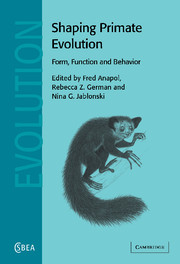Book contents
- Frontmatter
- Contents
- List of contributors
- Preface: shaping primate evolution
- 1 Charles Oxnard: an appreciation
- Part I Craniofacial form and variation
- Part II Organ structure, function, and behavior
- 6 Fiber architecture, muscle function, and behavior: gluteal and hamstring muscles of semiterrestrial and arboreal guenons
- 7 Comparative fiber-type composition and size in the antigravity muscles of primate limbs
- 8 On the nature of morphology: selected canonical variates analyses of the hominoid hindtarsus and their interpretation
- 9 Plant mechanics and primate dental adaptations: an overview
- 10 Convergent evolution in brain “shape” and locomotion in primates
- Part III In vivo organismal verification of functional models
- Part IV Theoretical models in evolutionary morphology
- Part V Primate diversity and evolution
- Index
- References
10 - Convergent evolution in brain “shape” and locomotion in primates
Published online by Cambridge University Press: 10 August 2009
- Frontmatter
- Contents
- List of contributors
- Preface: shaping primate evolution
- 1 Charles Oxnard: an appreciation
- Part I Craniofacial form and variation
- Part II Organ structure, function, and behavior
- 6 Fiber architecture, muscle function, and behavior: gluteal and hamstring muscles of semiterrestrial and arboreal guenons
- 7 Comparative fiber-type composition and size in the antigravity muscles of primate limbs
- 8 On the nature of morphology: selected canonical variates analyses of the hominoid hindtarsus and their interpretation
- 9 Plant mechanics and primate dental adaptations: an overview
- 10 Convergent evolution in brain “shape” and locomotion in primates
- Part III In vivo organismal verification of functional models
- Part IV Theoretical models in evolutionary morphology
- Part V Primate diversity and evolution
- Index
- References
Summary
Introduction
For many years, comparative studies have indicated that the sizes of mammalian brain components are mostly related to the size of the brain as a whole, suggesting that all mammals share smaller or larger versions of essentially the “same” brain (Preuss 1995). This prompted the view that mammalian brain evolution can be represented along a one-dimensional scale of encephalization or “general intelligence” (e.g., Jerison, 1973; Eisenberg, 1981; Harvey and Krebs 1990). Recently, such allometric regularities in brain morphology have been attributed to a highly conservative, uniformly mammalian “Bauplan,” which is thought to constrain the possible evolutionary responses to selection for specific neural reorganizations to those stemming from an orderly expansion of the brain as a whole (Finlay and Darlington, 1995; Finlay et al., 1998). From 1993 to 2001, I had both the privilege and the pleasure to work closely with Charles Oxnard, adapting his hypothesis-free approach to multivariate morphometrics (e.g., Oxnard, 1984), combined with modern data visualization techniques, to the comparative study of the brain in mammals. This allowed us to analyze a large number of brain variables across a broad range of mammals simultaneously (de Winter 1997).
We were able to show that the relative proportions of different systems of functionally integrated brain structures vary independently between different mammalian orders, demonstrating separate evolutionary radiations in mammalian brain organization (de Winter and Oxnard, 1996, 1997, 2001; de Winter, 1997).
Information
- Type
- Chapter
- Information
- Shaping Primate EvolutionForm, Function, and Behavior, pp. 206 - 226Publisher: Cambridge University PressPrint publication year: 2004
